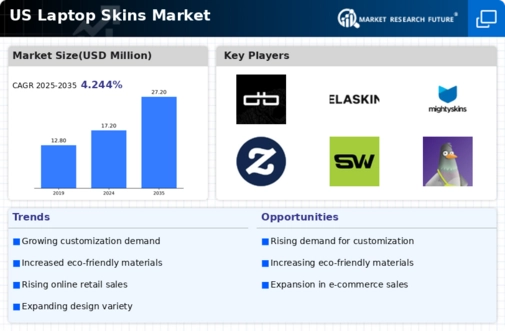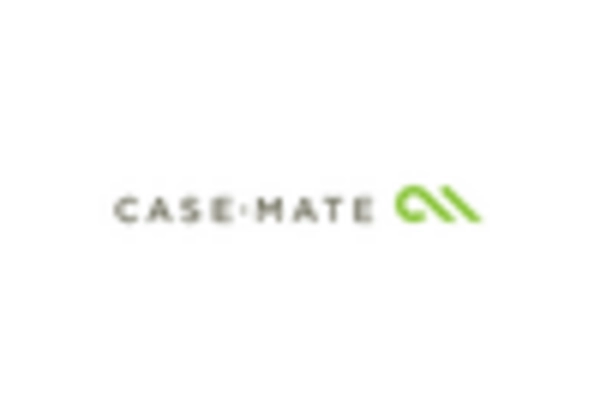Growing Trend of Remote Work
The laptop skins market is experiencing growth due to the increasing trend of remote work. As more individuals work from home, the demand for personalized and visually appealing workspaces has risen. In 2025, it is estimated that over 40% of the workforce will engage in remote work, leading to a heightened interest in customizing personal devices. Laptop skins serve as a practical solution for individuals looking to enhance their work environment while expressing their personality. This trend is particularly relevant among millennials and Gen Z, who prioritize aesthetics in their workspace. As a result, the laptop skins market is likely to see sustained growth, driven by the evolving nature of work and the desire for personalized workspaces.
Influence of E-commerce Growth
The laptop skins market is significantly influenced by the rapid growth of e-commerce platforms. As online shopping becomes increasingly prevalent, consumers are more inclined to purchase laptop skins through digital channels. In 2025, e-commerce sales in the electronics sector are expected to account for over 30% of total sales, providing a substantial boost to the laptop skins market. This shift towards online retail allows for a wider variety of designs and customization options, catering to diverse consumer preferences. Additionally, the convenience of online shopping enhances accessibility, enabling consumers to easily find and purchase laptop skins that align with their tastes. Consequently, the laptop skins market is poised for continued expansion as e-commerce continues to thrive.
Rising Demand for Aesthetic Appeal
The laptop skins market experiences a notable surge in demand driven by consumers' desire for aesthetic appeal. As individuals increasingly seek to personalize their devices, the market for laptop skins has expanded significantly. In 2025, the market is projected to reach approximately $1.5 billion in the US, reflecting a growth rate of around 10% annually. This trend is particularly pronounced among younger demographics, who view laptop skins as a means of self-expression. The proliferation of online platforms for custom designs further fuels this demand, allowing consumers to create unique skins that resonate with their personal style. Consequently, the laptop skins market is witnessing a transformation, where aesthetic considerations play a pivotal role in purchasing decisions.
Emergence of Eco-Friendly Materials
The laptop skins market is witnessing a shift towards eco-friendly materials, reflecting a broader trend in consumer preferences for sustainable products. As environmental concerns gain prominence, manufacturers are increasingly adopting biodegradable and recyclable materials for laptop skins. This shift is expected to attract environmentally conscious consumers, potentially increasing market share by 15% by 2025. The laptop skins market is adapting to these changes, with brands emphasizing their commitment to sustainability in marketing efforts. This not only appeals to a growing demographic of eco-conscious consumers but also aligns with regulatory trends favoring sustainable practices. Consequently, the integration of eco-friendly materials is likely to play a crucial role in shaping the future of the laptop skins market.
Increased Awareness of Device Protection
The laptop skins market benefits from a growing awareness among consumers regarding the importance of device protection. As laptops represent a significant investment, users are increasingly inclined to safeguard their devices from scratches, dust, and wear. The market is projected to grow by 8% annually, reaching an estimated $1.2 billion by the end of 2025. This heightened awareness is particularly relevant in the context of the rising costs associated with laptop repairs and replacements. Consumers are recognizing that investing in a laptop skin not only enhances the device's appearance but also prolongs its lifespan. Thus, the laptop skins market is positioned to capitalize on this trend, as more individuals prioritize protective measures for their electronic devices.

















Leave a Comment